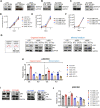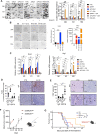Axon guidance cue SEMA3A promotes the aggressive phenotype of basal-like PDAC
- PMID: 38670629
- PMCID: PMC11287654
- DOI: 10.1136/gutjnl-2023-329807
Axon guidance cue SEMA3A promotes the aggressive phenotype of basal-like PDAC
Abstract
Objective: The dysregulation of the axon guidance pathway is common in pancreatic ductal adenocarcinoma (PDAC), yet our understanding of its biological relevance is limited. Here, we investigated the functional role of the axon guidance cue SEMA3A in supporting PDAC progression.
Design: We integrated bulk and single-cell transcriptomic datasets of human PDAC with in situ hybridisation analyses of patients' tissues to evaluate SEMA3A expression in molecular subtypes of PDAC. Gain and loss of function experiments in PDAC cell lines and organoids were performed to dissect how SEMA3A contributes to define a biologically aggressive phenotype.
Results: In PDAC tissues, SEMA3A is expressed by stromal elements and selectively enriched in basal-like/squamous epithelial cells. Accordingly, expression of SEMA3A in PDAC cells is induced by both cell-intrinsic and cell-extrinsic determinants of the basal-like phenotype. In vitro, SEMA3A promotes cell migration as well as anoikis resistance. At the molecular level, these phenotypes are associated with increased focal adhesion kinase signalling through canonical SEMA3A-NRP1 axis. SEMA3A provides mouse PDAC cells with greater metastatic competence and favours intratumoural infiltration of tumour-associated macrophages and reduced density of T cells. Mechanistically, SEMA3A functions as chemoattractant for macrophages and skews their polarisation towards an M2-like phenotype. In SEMA3Ahigh tumours, depletion of macrophages results in greater intratumour infiltration by CD8+T cells and better control of the disease from antitumour treatment.
Conclusions: Here, we show that SEMA3A is a stress-sensitive locus that promotes the malignant phenotype of basal-like PDAC through both cell-intrinsic and cell-extrinsic mechanisms.
Keywords: PANCREATIC CANCER.
© Author(s) (or their employer(s)) 2024. Re-use permitted under CC BY. Published by BMJ.
Conflict of interest statement
Competing interests: None declared.
Figures







References
Publication types
MeSH terms
Substances
Grants and funding
LinkOut - more resources
Full Text Sources
Medical
Molecular Biology Databases
Research Materials
Miscellaneous
